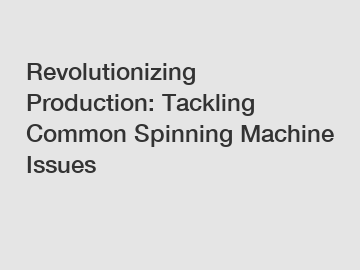In every industry, the pursuit of better production methods and increased efficiency is an ongoing challenge. The textile industry, particularly the spinning process, is no exception. Spinning machines are the backbone of any textile production facility, and when they encounter common issues, they can significantly impact productivity. However, with advancements in technology and innovative solutions, these problems can now be effectively addressed, revolutionizing the production process. In this blog, we will explore some of the most common spinning machine issues and the cutting-edge solutions available today.
1. Issue: Yarn Breakage.
Yarn breakage can hinder the smooth operation of spinning machines, leading to reduced production rates and increased waste. Traditional machinery often lacks the ability to detect and address this issue efficiently, resulting in production losses. However, new-generation spinning machines have adopted advanced sensors and monitoring systems that can promptly detect yarn breakage. By leveraging real-time data and automatic control mechanisms, these machines can make instant adjustments, minimizing downtime and maximizing productivity.

2. Issue: Uneven Yarn Quality.
Achieving consistent and high-quality yarn is crucial in the textile industry. However, variations in spinning machine speed, tension, or fiber input can result in uneven yarn quality. This issue is being tackled by the implementation of intelligent spinning machines equipped with automated controls. These machines monitor and adjust critical factors continuously, ensuring that the yarn produced is consistent in terms of thickness, strength, and appearance, thereby meeting the stringent quality requirements of the industry.
3. Issue: Energy Consumption.
Energy efficiency is a major concern for all industries, and the textile sector is no different. Traditional spinning machines often consume significant amounts of energy, contributing to higher production costs and environmental damage. Fortunately, modern spinning machines are designed with energy-saving features in mind. Improved motor efficiency, intelligent control algorithms, and optimized machine design have led to substantial reductions in energy consumption. This not only benefits the environment but also helps in cost savings, making the production process more sustainable.
4. Issue: Machine Maintenance and Downtime.
Spinning machines require regular maintenance to remain in optimal condition. Unscheduled downtime for maintenance can disrupt production schedules and affect profitability. To overcome this challenge, automatic maintenance systems have been incorporated into spinning machines. These systems monitor the condition of various machine components using sensors and data analysis. By accurately predicting potential failures and scheduling preventive maintenance tasks, these machines minimize downtime and extend the lifespan of critical components.
5. Issue: Labor Intensity and Skill Requirements.
Traditional spinning machines often require skilled operators to monitor and control the production process manually. However, the textile industry grapples with a shrinking skilled labor pool, making it challenging to find qualified personnel. To alleviate this issue, spinning machines now offer enhanced automation capabilities. With modern machines, many complex tasks, such as fiber handling and tension control, can be automated. This not only reduces labor intensity but also ensures consistent output, irrespective of the operator's skill level.
Conclusion:
Revolutionizing production in the textile industry involves addressing common spinning machine issues head-on. With advancements in technology and innovative solutions, modern spinning machines offer remarkable efficiency, higher quality production, and reduced environmental impact. By tackling problems such as yarn breakage, uneven yarn quality, energy consumption, machine maintenance, and labor intensity, these machines have significantly transformed the textile manufacturing landscape. As the industry continues to evolve, the continuous development and adoption of cutting-edge spinning machine technologies remain essential for further revolutionizing production processes.
For more copper spinning machine, CNC Spinning And Turning Machine, CNC Spinninginformation, please contact us. We will provide professional answers.



Comments
Please Join Us to post.
0